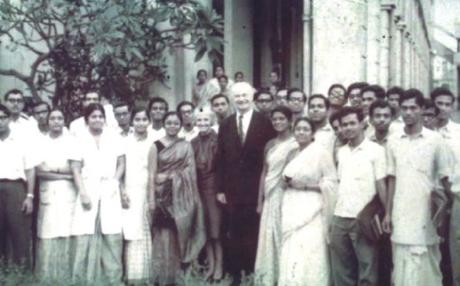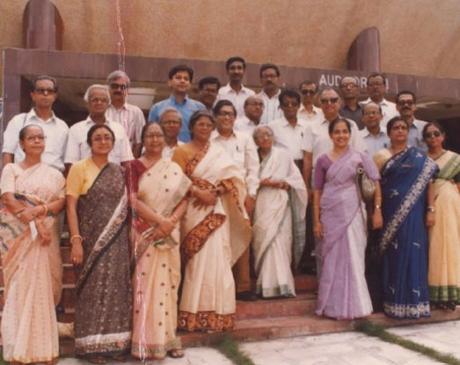
Asima Chatterjee (front row, third from right) with her students and the Paulings, February 1967. Credit: Indian Academy of Sciences
[An examination of Linus and Ava Helen Pauling’s relationship with the influential Indian chemist, Asima Chatterjee. Part 2 of 2.]
Asima Chatterjee’s one and only meeting with Linus and Ava Helen Pauling took place during the Paulings’ tour of India, which spanned the months of January and February 1967. During the final leg of this trip, for a mere sixteen hours, the Paulings landed in Kolkata, toured the University, saw Chatterjee’s labs, and met her students. From there the Paulings departed India en route to Honolulu, where they planned to spend a few days visiting with their son, Linus Jr. Before leaving however, the Paulings gave a sum of money to Chatterjee that they later requested she spend on a wedding gift from them for her daughter. Though a small token, this gift was surely an indication of the esteem that the Paulings felt for their friend and fellow scientist.
While 1967 began on a high note for Chatterjee, the year ultimately proved to be profoundly difficult. In the months following the Paulings’ departure, Chatterjee lost both her husband and her father. Congruent with these personal tragedies, the political environment in Chatterjee’s home region of West Bengal, and particularly in Kolkata, began to deteriorate as a radical communist group, the Naxalites, began to gain influence in the area.
While the details of Chatterjee’s personal heartache, as well as India’s mounting regional strife, were communicated in her letters to the Paulings, one is also able to intuit a degree of solace being found in correspondence. In particular, Chatterjee was keen to point out Linus Pauling’s sweeping geniality and friendship, commenting that “we all admire his enthusiasm and unlimited energy. He is so dynamic! We wonder where he gains this energy.”
Though first and foremost a scientist, Asima Chatterjee’s concerns for her home country’s well-being echoed similar frustrations being felt by her stateside correspondents. While the Paulings were focused primarily on global problems of the nuclear age, in India the worries were more acute. In particular, the need to navigate and correct a wide array of political, social and economic dysfunctions left behind by the colonial era proved to be a momentous and primary challenge.
The strains of adjusting to a new era of independence that were felt nation-wide also impacted Chatterjee in a multitude of ways. Professionally, many students at her university abandoned their studies to join the Naxalites in protest. As these demonstrations grew in intensity, splinter groups resorted to attacks on Kolkata’s infrastructure that resulted in damage to the city’s power grid.
During this period of tumult, Chatterjee’s concern for the fortunes of her students, her daughter and, indeed, her country were evident in her communications with Ava Helen. In their letters, the two women discussed a number of social issues, including student unrest around the world, Kolkata’s seemingly intractable troubles, and the escalation of violence in Vietnam. In a 1971 letter, Ava Helen expressed her sympathy for Chatterjee’s plight. “The world gets no better and we have been full of sorrow and anxiety for India the past year,” she wrote. “It is so dreadful that the world refuses to try another method.”
Replying a few weeks later – during the final months of a genocidal campaign that resulted in the deaths of between 300,000 and 3 million people in present-day Bangladesh – Chatterjee expressed growing dismay about the state of affairs on the subcontinent.
Air raid sirens and black outs are frequent occurrences in the city. The number of refugees in India is beyond imagination… It is not possible for India to look after those millions of refugees permanently.
Though she could not have known the final tally at that time, statistics now show that some 10 million refugees fled Bangladesh for India in 1971.

Asima Chatterjee (at center in white sari) with some of her students, 1997. Credit: Indian Academy of Science.
Chatterjee also noted that academic rigor at the University of Calcutta had diminished, suggesting that “the University has been converted into a machine for turning out [hundreds] of graduates every year.”
And yet, in spite of it all, Chatterjee remained very productive. By 1961 she had published 105 peer-reviewed papers and, in 1972, she was selected to be the honorary Programme Coordinator at the Centre for Advanced Studies in Chemistry of Natural Products. Three years later, she became the first woman to be elected as General President of the Indian Science Congress Association.
In 1982, after retiring from her duties as a professor, Chatterjee received a very different kind of honor when she was selected to a seat in the Raiya Sabha. A component of India’s parliament, the Raiya Sabha consists of twelve nationals who, in the estimation of the President, have made a profound impact on their fields. Chatterjee served in this is position until 1990. She died sixteen years later, on November 22, 2006, and is survived by her daughter Julie Banerji, a professor in the Department of Chemistry at the University of Calcutta.
The global friendship shared by Linus Pauling, Ava Helen Pauling and Asima Chatterjee was certainly unorthodox — in person, the relationship consisted entirely of a single, half-day meeting. Through the power of the pen however, the Paulings and Chatterjee cemented and grew their fondness for one another, regularly exchanging holiday greetings and carrying out various professional favors. Today, their bond stands as evidence in support of the imperative that knowledge flow freely across social and geographic boundaries. Their story also serves as an example of the ways in which science and concerns for humanity are so often intertwined.
Advertisements &b; &b;